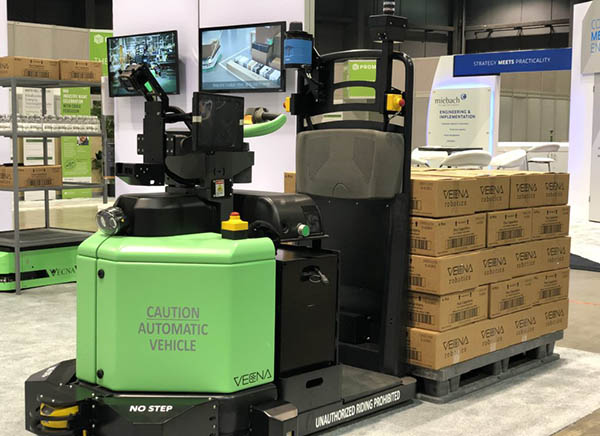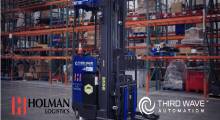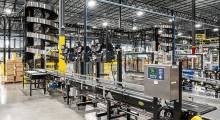From pallets to warehouse workflows, Vecna Robotics provides robots and software to automate materials handling. Last week, the Waltham, Mass.-based company announced that it has raised Series C funding of $65 million.
Vecna said it plans to use the investment to develop new robots and software, fufill orders, and expand operations as it serves a $165 billion market for autonomous pallet moving. Robotics 24/7 spoke with Craig Malloy, CEO of Vecna Robotics, about the financing and his perspective on the market and his company's role in it.
Funding to help Vecna scale and meet demand
Is Vecna Robotics going to use some of its Series C funding to hire more people, and if so, what kinds—engineering, business, etc.?

Malloy: Most of the company's focus has been on the highly technical team developing the core IP [intellectual property] for solving material handling problems. It's an innovators' market.
The board asked me to come on board to scale the business side—that's a core focus of what we're doing with the investment. We're building out critical mass for sales and marketing, human resources, and finance.
We're certainly continuing to invest in engineers, who are still perfecting our solutions for automating the movement of pallet-size loads. We're not focusing on case picking or each picking.
How have supply chain and labor challenges around the COVID-19 pandemic affected interest in Vecna's systems? Are there any that are in particular demand?
Malloy: With the lockdowns in April 2020, the company had time to hone its offerings. We couldn't get into warehouses, and there was an acceleration of need combined with a good product-market fit. It was not just a technical problem and a solution.
It turned out there was a huge demand for vehicles that could move 5,000 lb. in warehouses and manufacturing economically alongside people and other vehicles.
There were two things that ramped up demand. The first was the explosion of e-commerce warehousing closer to city centers. I live near Austin, and it's shocking how many new warehouses are going up around here. Each has 100 dock doors, with pallets or packages for induction and more large loads.
Then came the “Great Resignation” and a rejiggering of the workforce. Wage rates are going up, and there's inflation. One large customer, which runs its own distribution centers, pays $62,000 a year for a driver and added three shifts for productivity.
Coming out of the pandemic, people are taking a fresh look at automation. We have more customers and bigger deals; it's not “tire-kickers” anymore. One company in our pipeline went from eight to 10 robots in one warehouse and is now looking to automate 20 warehouses and add workflows.
In manufacturing, which is also a good customer base, the automakers are retooling for electric vehicles and are building new facilities. They're all looking at automation first, even when they're not building 100% new factories. They're designing with automation—and not just robotic arms for assembly—- in mind.
Pivotal improves AMR capabilities
What has the market reception been like for Vecna's Mark 3 orchestration software? Are there specific environments where the ability to increase speed is especially helpful?
Malloy: It's been great. The software is just one piece of Pivotal. We can push an update, and AMRs [autonomous mobile robots] get 50% faster, and pickup times drop 30%.
We have a unique architecture: All our AMRs are cloud-connected. Not only can Vecna push out updates, but we also have no fixed infrastructure, offering flexibility in moving production lines around. We can redefine travel lanes and pickups in seconds through Pivotal. We had a carmaker in the office recently, and that was a big selling point.
What features are you looking to expand in or add to Pivotal?
Malloy: We haven't yet completely fulfilled the grand vision of orchestrating people, equipment, and robots. We're installing dozens of AMRs at sites where Pivotal orchestrates and optimizes material flow in conjunction with the WMS [warehouse managment system].
As for our product roadmap, customers are asking for real-time views of productivity on their phones. “Where are my robots, and what are they doing? How many pallets were picked up today?”
We have that information from cloud-connected devices and our data warehouse. We're working to make that information as user-friendly as possible and present it through a Web-based user interface. Our software updates and dashboard are designed around the whole notion of the customer experience.
Malloy joins leading team
How are you settling into the role of CEO at Vecna Robotics? What aspects of its corporate culture have you embraced?
Malloy: I've been at Vecna for seven or eight months. I've been the founder and CEO of several venture-funded growth companies in the enterprise communications space. This is the first time I've been a CEO of a company where I wasn't the founder.
Daniel [Theobald, founder and now chief innovation officer of Vecna Robotics] has built a great culture. Because I've been a founder, I know how fragile that is in a growth-stage company. I was very careful to come up and listen and learn and be respectful and understand the culture.
I've focused on where I can add value. I'm not an MIT-trained engineer, but I was a Navy officer. Vecna has added a couple of new executives, including a chief marketing officer, a senior vice president of product management, and a chief people officer.
We're building on the foundation of the strong engineering culture to move the company forward. This allows Daniel to focus on innovation, and for me to use my expertise in building out solutions that are deployable, scalable, and secure.
Vecna is a leading robotics company in the Boston area and a member of MassRobotics. How does being part of the Massachusetts robotics community help it innovate and grow?
Malloy: Daniel and Bob Davis, managing partner of Highland Capital, have been very generous with their time and introducing me to people. As a manager, I've spent the majority of my time focused on what we're doing as a fast-paced business.
It's part of a good division of labor. Daniel is so plugged into the local scene and has relationships with many robotics companies. I definitely want to spend more time in Boston.
In addition, he's a great thought leader. Take, for example, Daniel's vision around interoperability and gathering competitors to move the industry forward. Vecna participated in the development and demonstration of MassRobotics' AMR interoperability standard.
About the Author
Follow Robotics 24/7 on Linkedin
Article topics
Email Sign Up

















